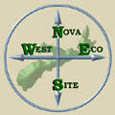Code of Ethics
In 1980, the Special Places Act was passed to protect all archaeological, geological,
historical and paleontological sites. A Heritage Research permit is required to do any
digging for artifacts. Only one or two loose and small fossils are allowed to be picked up
from the surface of a finding. The position of artifacts relative to other fossils is a
key factor in proper inference and identification. If a fossil is not immediately
vulnerable to destruction, for instance, it is not below the Bay of Fundy tideline on a
smooth sandy beach, it is still advisable to leave the artifact where it lies. Other
fossils located below the tideline on cliffs and underwater or partly submerged ridges,
should not be removed even though they are in danger of being eroded by the high
tides. Due to tidal activities fossils may have been moved around a great
distance. Fossils which appear to have moved on a daily basis are safe to retrieve
but should be reported to the Nova Scotia museum. It is imperative that the Nova
Scotia Museum of Natural History be contacted to confirm and classify retrieved or
discovered artifacts. Hammering as well digging, is strictly prohibited because
fossils may get smashed. A more wise course of action would be to directly contact
the Nova Scotia
Museum of Natural History in Halifax through email (museum-info@gov.ns.ca) or phone at
(902) 424-7370.
Heritage Research Permit
Experts licensed under the Heritage Research permit for the Special
Places Act use small precise tools, such as artist's paintbrushes and
spoons to carefully uncover physical data on a discovered site. Even the experts are
required do report their subsequent findings to the Nova Scotia Museum in Halifax.
Anyone with organized procedures for acquiring physical data may apply for a Heritage
Research license. However, with regard to non-Nova Scotian experts the Heritage
research license is now issued upon the promise that all artifacts will be returned if
taken outside the province for further study.
Tide Tables
Tide tables can be analysed from the local newspapers such as the
Chronicle-Herald to determine when the tide is going to be
low. A good time is around the mid-day low tide occurrence,
while the sun has an opportunity to dry the area. For further
information see the
Bay of Fundy tides.
Hotspots
The main dinosaur findings for Nova Scotia overall are
the Joggins petrified trees and the Parrsbro findings. However, triassic/jurassic
formations run down from the Minas Basin-where other major finds have been
established-along the north mountains and around the Annapolis River. Long and Brier
islands combine jurassic/triassic formations. The base of the St. Mary's Bay is solely
triassic, a formation that encompasses the Annapolis River. The Annapolis River is
approximately centred within this Triassic region which continues on to the Minas Basin
in a gradually widening strip adjacent to the outer Jurassic / Triassic region which
begins at Cape Blomidon and ends at the Brier Island. This means that fossil discoveries
are possible for our region and findings have already been made in areas such as Red Head
which is a knoll adjacent to a triassic faultline, jutting into the St. Mary's Bay. Other
findings in the bay include a stagonolepsis skull. A "sunken forest" is
located at the head of the St. Mary's Bay. According to the Fundy Geological Museum,
Dr. Paul Olsen found the upper part of a Phytosaur's skull, an armour scale, and part of a
jaw. Reptilian and dinosaurian footprints have also been discovered in St.
Mary's Bay area along the beach near Rossway. The skull of a Stagonolepsis
was discovered in the St. Mary's Bay as well as fossils dated from the Torbrook formation
in Bear River.
If a finding is made, it is recommended that the site be outlined on a map,
photographed, and described on paper. Fossils should be reported to the Nova Scotia
Museum of Natural History or the Nova Scotia Museum, located in Halifax.
Contact Information for Findings
Nova Scotia
Museum of Natural History
1747 Summer Street, Halifax, NS, Canada
B3H 3A6
(902) 424-7353 Fax: (902) 424-0560
Natural History Inquiries: (902) 424-7370
URL: http://nature.ednet.ns.ca
Museum Information: museum-info@gov.ns.ca
Mineral/Rock Collecting
There are two main rock formations along the Bay of Fundy.
The Basalt formation begins in the Scots Bay and extends west to include
Brier Island. The conglomerate region is the next inland layer
running parallel to the Basalt formation, beginning inland from the
Scots bay at Blomidon, extending west to the St. Mary's Bay.
Mainly, quartz and zeolites can be found in the basalt formation along
the shoreline. The best time for rock collecting is after the
late spring thaw. For more detailed information on all West
Nova geological formations see the Geography
& Geology section.









